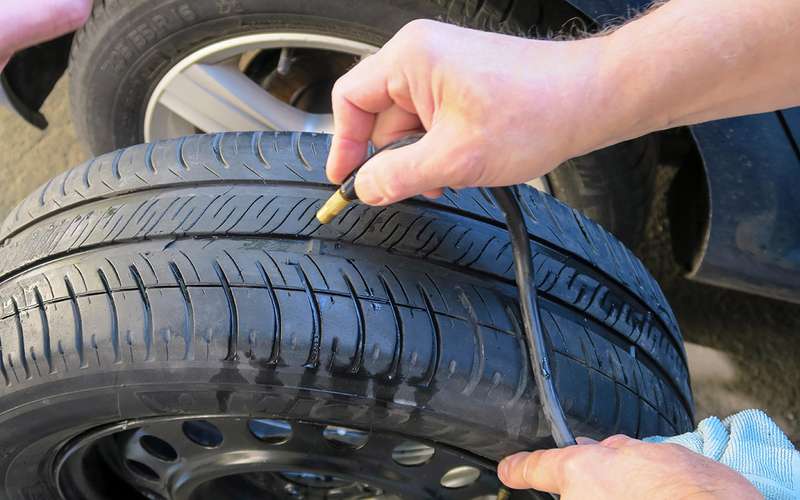A tire repair kit is a must-have in the trunk – you never know when you’ll need it. Our test of 14 repair kits will help you choose the one that’s right for you, and repair a cut or a puncture – the advice of experts from “Behind the wheel”.
If Pierced: 6 Important Notes
- Use only “classic” flagella reinforced with synthetic threads. Outwardly, they resemble a twisted rope impregnated with a rubbery compound. Do not use tapered plugs or unreinforced strips.
- Inflate the wheel to a minimum of 0.5-1.0 bar before starting repairs.
- If in doubt about the quality of your repair, slide the repaired wheel back.
- If a puncture is detected while driving and it is impossible to make immediate repairs, do not rush to remove a nail or self-tapping screw protruding from the tire (the latter can even be tightened with a screwdriver) . As long as it’s in place, the tire won’t deflate as quickly. When mounting a tire, it is better to occasionally inflate a flat wheel.
- Remember that with the presence of glue in the sealant, the installation of the flagellum becomes easier and the probability of its longevity is increased.
- If the sealant has been in the trunk for a long time and the glue has dried, you can use gasoline instead (but not diesel fuel).
What tools are needed to repair a tire?
All sets are sold in a blister pack or in a plastic bag. But even in the store you can inspect the working surfaces of the tools and make the right choice. The kit for installing flagella usually includes two tools: cleaningcleaning a hole in the tire, and awl with hole – actually before the introduction of the turnstile.
Cleaning, it is a cleaning or, even simpler, a picker, there are three types. A versatile workpiece curled with a spiral cleans the hole from dirt quite well and does not injure the metal cord at all. Cleaning with an angled notch is similar to a grater. If the teeth are not too sharp, it can also be used, but the supply of glue in the hole will be worse.
We strongly advise against using cleaning with sharp aggressive teeth. It is very difficult to use it, while something is constantly grinding, and this is the cord of your tire!
From cleaning – to an awl with a slotted needle eye.
The forked tip must be sharp enough and the gap between the halves must be minimal, otherwise it will be difficult to insert it into the hole. There is a risk that the wire of the metal cord will fall into the slot. The hole for threading the flagellum should have non-sharp edges. And, most importantly, see if it will be easy for the flagellum to exit through the slit already in the band. For convenience, you can file the exit of the ear with a file to get the perfect profile.
The most useful tools are those with a T-handle.
What consumables are needed?
Flagella are better to take thicker. To touch, even through polyethylene, they must be soft.
With glue, the installation of flagella is easier and more reliable – when pulling out the awl, it acts as a lubricant, facilitating movement. The tube should feel heavy, indicating that the contents have not dried out.
In extreme cases, any flagella can be installed without glue and moistened with gasoline.
What else do you need?
Without compressor it makes no sense to do the work. It will help to find a hole if it was left by a nail in the board, not a self-tapping screw in the tire. water, preferably soapy water. It is sometimes very difficult to remove a self tapping screw, so it will come in handy pliers. When the flagellum is already installed, the protruding tails should be cut flush with the protector. BUT knifeas it turned out, is rarely included in the kit.
How to repair?
- We find a hole in the tire. Holes up to 6 mm flagella join freely, although there are cases of lateral wall sealing holes up to 15 mm with a bunch of flagella at a time.
- In the front tire, the hole can be found without removing, but only by turning the wheel and rolling the car. The back usually has to be removed.
- If the holes are not immediately visible, rinse the tire with soapy water.
- We remove the culprit from the flat tire.
- Dry the puncture site.
- We clean the hole with several cleaning movements, moving at the same angle as the object that leaked the tire.
- We apply glue to the cleaning and in a few strokes we put glue into the hole.
- We insert the flagellum into the awl.
- We apply glue to the awl and the surface of the flagellum.
- With force we push the awl into the hole, but we regulate its depth so that the ends do not fall through it and so as not to leave the entire flagellum in the band.
- We take out the awl – the flagellum remains.
- We cut short the tails of the flagellum. On the tread block – “to zero”, in the groove – you can just leave it outside.
- We inflate the tire, check the result.
Which secrets are the most reliable, we have told here.
“Behind the wheel” can also be read on VKontakte.
We wish that our advice will never be useful to you! But we strongly recommend that you have a suitable repair kit in stock.










